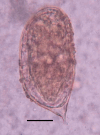Human Passage of Schistosoma incognitum, Tamil Nadu, India, and Review of Autochthonous Schistosomiasis, South Asia
- PMID: 38782022
- PMCID: PMC11138999
- DOI: 10.3201/eid3006.231641
Human Passage of Schistosoma incognitum, Tamil Nadu, India, and Review of Autochthonous Schistosomiasis, South Asia
Abstract
A fecal survey in Tamil Nadu, India, revealed 2 persons passed schistosome eggs, later identified as Schistosoma incognitum, a parasite of pigs, dogs, and rats. We investigated those cases and reviewed autochthonous schistosomiasis cases from India and Nepal. Whether the 2 new cases represent true infection or spurious passage is undetermined.
Keywords: India; Nepal; Schistosoma; Schistosomiasis; parasites; zoonoses.
Figures


Similar articles
-
Schistosoma incognitum and its zoonotic potential role in Phitsanulok and Phichit provinces, northern Thailand.Southeast Asian J Trop Med Public Health. 1983 Jun;14(2):163-70. Southeast Asian J Trop Med Public Health. 1983. PMID: 6635754
-
Some facts on south asian schistosomiasis and need for international collaboration.Acta Trop. 2018 Apr;180:76-80. doi: 10.1016/j.actatropica.2017.12.022. Epub 2017 Dec 19. Acta Trop. 2018. PMID: 29273443 Review.
-
The pig as a host for Schistosoma mekongi in Laos.J Parasitol. 2001 Jun;87(3):708-9. doi: 10.1645/0022-3395(2001)087[0708:TPAAHF]2.0.CO;2. J Parasitol. 2001. PMID: 11426741
-
Unexpected Zoonotic and Hybrid Schistosome Egg Excretion Patterns, Malawi, 2024.Emerg Infect Dis. 2025 May;31(5):1042-1045. doi: 10.3201/eid3105.241757. Emerg Infect Dis. 2025. PMID: 40305402 Free PMC article.
-
Reduce Disease Burden of Human Schistosomiasis in Asia Through Biological Control.Mini Rev Med Chem. 2020;20(12):1118-1132. doi: 10.2174/1389557520666200204114646. Mini Rev Med Chem. 2020. PMID: 32013848 Review.
References
-
- Chandler AC. A new schistosome infection of man, with notes on other human fluke infections in India. Indian J Med Res. 1926;14:179–83.
-
- Ajjampur SSR, Kaliappan SP, Halliday KE, Palanisamy G, Farzana J, Manuel M, et al. Epidemiology of soil transmitted helminths and risk analysis of hookworm infections in the community: Results from the DeWorm3 Trial in southern India. PLoS Negl Trop Dis. 2021;15:e0009338. 10.1371/journal.pntd.0009338 - DOI - PMC - PubMed
-
- Agrawal MC. The schistosomes. In: Agrawal MC editor. Schistosomes and schistosomiasis in South Asia. New Delhi: Springer India; 2012. p. 7–50.
Publication types
MeSH terms
LinkOut - more resources
Full Text Sources
Medical

